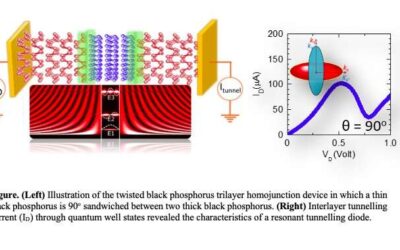Sensors that can detect magnetic fields have many potential applications, for instance, in the development of sophisticated medical devices and transportation systems. Most approaches for detecting 3D magnetic fields developed so far, however, require several sensors,...
Electronics & Semiconductors
Researchers realize resonant tunnelling diodes based on twisted black phosphorus homostructures
In recent years, electronics engineers worldwide have been trying to develop new semiconductor heterostructure devices using atomically thin materials. Among the many devices that can be fabricated using these materials are resonant tunneling diodes, which typically...
A new strategy to enhance the performance of silicon heterojunction solar cells
Crystalline silicon (c-Si) solar cells are among the most promising solar technologies on the market. These solar cells have numerous advantageous properties, including a nearly optimum bandgap, high efficiency and stability. Notably, they can also be fabricated using...
Researchers create a new transistor based on metal nanoparticles and ionic gradients
Transistors, devices that can amplify, conduct or switch electronic signals or electric current, are key components of many electronics on the market today. These devices can be fabricated using a variety of inorganic and organic semiconducting materials.
Researchers create a hybrid technology that combines III-V tunnel FETs and MOSFETs
Over the past few decades, the incredible progress made in the electronics industry has been partially driven by innovations at the single-transistor level. A transistor is a semiconducting device that can conduct, insulate and amplify electric current inside...
A design to improve the resilience and electrical performance thin metal film based electrodes
Flexible electrodes, electronic components that conduct electricity, are of key importance for the development of numerous wearable technologies, including smartwatches, fitness trackers and health monitoring devices. Ideally, electrodes inside wearable devices should...
A machine learning framework that exploits memristor variability to implement Markov chain Monte Carlo sampling
Memristors, or resistive memory devices (RRAM) are nanometer-sized electronic components that can serve as memories for portable computers and other devices. When they are organized in a cross-bar structure, these tiny memories can be used to perform matrix...
Researchers review advancements in the development of stretchable transistors
Over the past few decades, researchers have been trying to develop electronic components that are increasingly flexible and skin-like, as these could enable the fabrication of new wearable and implantable devices. Transistors, semiconductors that can conduct and...
A method to track the outdoor performance of perovskite solar minimodules
In recent years, researchers have been developing a wide range of technologies designed to convert renewable energy sources, such as sunlight and wind, into electrical energy. This includes solar or photovoltaic (PV) cells, devices that can convert light into...
A strategy to improve the efficiency and long-term stability of perovskite solar cells
Over the past few years, researchers have been trying to develop new designs for perovskite solar cells that could improve their performance, efficiency and stability over time. One possible way of achieving this is to combine 2-D and 3-D halide perovskites in order...









